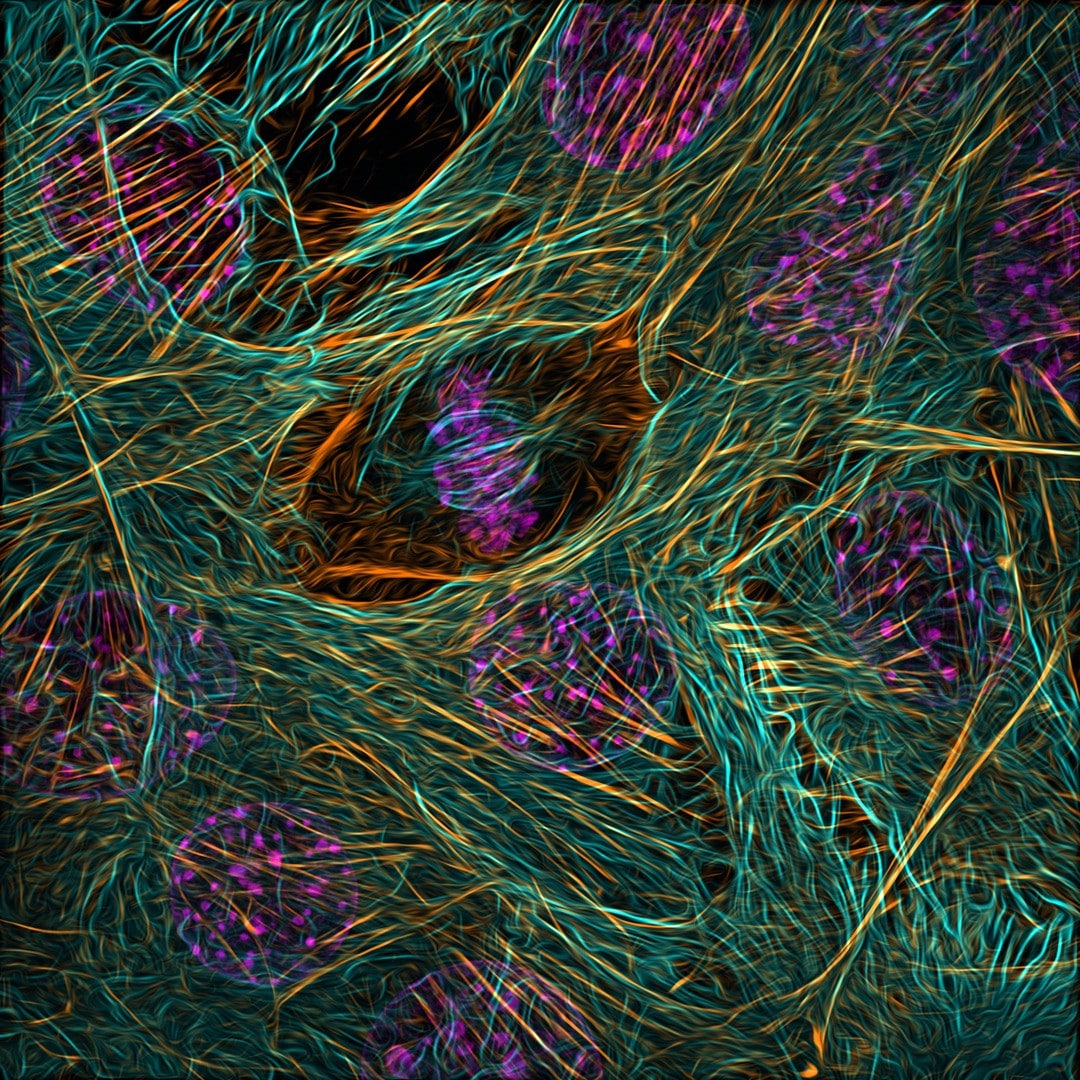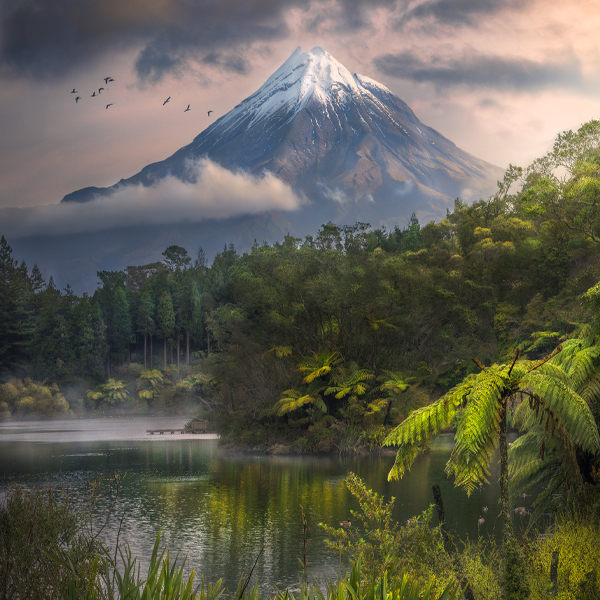
1st Place, Hassanain Qambari & Jayden Dickson., The Lions Eye Institute Department of Physiology & Pharmacology, Perth, Western Australia, Australia. Rodent optic nerve head showing astrocytes (yellow), contractile proteins (red) and retinal vasculature (green). Confocal, Fluorescence, Image Stacking, 20X (Objective Lens Magnification)
A look at a rodent's optic nerve under the microscope took home the top prize at the 49th annual Nikon Small World Photomicrography Competition. Taken by Hassanain Qambari, who was assisted by Jayden Dickson, the psychedelic image won out over nearly 1,900 entries from 72 countries.
The image is not only beautiful, but medically important, as it provides an important contribution to the study and reversal of diabetic retinopathy, which affects one in five persons with diabetes worldwide. Diabetic retinopathy occurs when high blood sugar damages the retina, leading to blurry vision or loss of eyesight.
“Current diagnostic criteria and treatment regimens for diabetic retinopathy are limited to the late-stage appearance of the disease, with irreversible damage to retinal microvasculature and function,” said Qambari. “The visual system is a complex and highly specialized organ, with even relatively minor perturbations to the retinal circulation able to cause devastating vision loss. I entered the competition as a way to showcase the complexity of retinal microcirculation.”
Qambari hopes that this win will spotlight the issue, as well as inspire a new generation to pursue a career in STEM. As usual, all of the top 20 images highlight the artistry of science. With a wide variety of subjects and photomicrography techniques, the winning scientists and researchers are certainly inspirational.
From the head of a matchstick being struck to the fangs of a tarantula, some photos show familiar objects in a new light. Others explore cells, embryos, and cytoskeletons in a way that wouldn't be possible without the help of a microscope.
Keep scrolling to see the top 15 photos from the 2023 Nikon Small World Photomicrography Competition and view the full winner's gallery online.
These are the winners of the 2023 Nikon Small World Photomicrography Competition.

2nd Place, Ole Bielfeldt, Macrofying, Cologne, North Rhine-Westphalia, Germany. Matchstick igniting by the friction surface of the box. Brightfield, Image Stacking, 2.5X (Objective Lens Magnification)

4th Place, John-Oliver Dum, Medienbunker Produktion, Bendorf, Rheinland-Pfalz, Germany. Venomous fangs of a small tarantula. Image Stacking, 10X (Objective Lens Magnification)

9th Place, Vaibhav Deshmukh, Baylor College of Medicine, Department of Molecular Physiology and Biophysics, Houston, Texas, USA. Cytoskeleton of a dividing myoblast; tubulin (cyan), F-actin (orange) and nucleus (magenta). Fluorescence, Structured Illumination Microscopy (SIM), 63X (Objective Lens Magnification)

11th Place, Dr. Diego García, Universidad Complutense de Madrid, Real Sociedad Española de Física, Madrid, Spain. Crystallized sugar syrup. Polarized Light, 25X (Objective Lens Magnification)

6th Place, Timothy Boomer, WildMacro.com, Vacaville, California, USA. Slime mold (Comatricha nigra) showing capillitial fibers through its translucent peridium. Image Stacking, 10X (Objective Lens Magnification)
Now in its 49th year, the contest highlights the artistry of science.

7th Place, Dr. Grigorii Timin & Dr. Michel Milinkovitch, University of Geneva, Department of Genetics and Evolution, Geneva, Switzerland. Mouse embryo. Light Sheet, 4X (Objective Lens Magnification)

13th Place, Satu Paavonsalo & Dr. Sinem Karaman, University of Helsinki, Individualized Drug Therapy Research Program, Faculty of Medicine, Helsinki, Finland. Blood and lymphatic vasculatures in the ear skin of an adult mouse. Confocal 10X, (Objective Lens Magnification)

12th Place, Sherif Abdallah Ahmed. Faculty of Science, Tanta University, Department of Zoology, Tanta, Egypt, Arab Republic. “Cuckoo wasp” standing on a flower. Image Stacking, 4X (Objective Lens Magnification)

14th Place, John-Oliver Dum, Medienbunker Produktion, Bendorf, Rheinland-Pfalz, Germany. Sunflower pollen on an acupuncture needle. Image Stacking, 40X (Objective Lens Magnification)
Nearly 1,900 images from 72 countries were entered into this year's photo contest.

3rd Place, Malgorzata Lisowska, Independent, Value Based Healthcare Consultant, Warsaw, Mazowieckie, Poland. Breast cancer cells. Brightfield, Image Stacking, 40X (Objective Lens Magnification)

10th Place, Melinda Beccari & Dr. Don W. Cleveland, UC San Diego, Department of Cellular and Molecular Medicine, La Jolla, California, USA. Motor neurons grown in microfluidic device for separation of cell bodies (top) and axons (bottom). Green – microtubules; Red – growth cones (actin). Confocal, Fluorescence, 20X (Objective Lens Magnification)

8th Place, Stefan Eberhard, University of Georgia, Athens, Georgia, USA. Caffeine crystals. Polarized Light, 25X (Objective Lens Magnification)

5th Place, Dr. David Maitland, Feltwell, Norfolk, United Kingdom. Auto-fluorescing defensive hairs covering the leaf surface of Eleagnus angustifolia exposed to UV light. Fluorescence, Image Stacking, 10X (Objective Lens Magnification)

15th Place, Dr. Pichaya Lertvilai. UC San Diego, Scripps Institution of Oceanography, La Jolla, California, USA. Fluorescent image of an Acropora sp. showing individual polyps with symbiotic zooxanthellae. Darkfield, Fluorescence, Image Stacking, 5X (Objective Lens Magnification)






















































































